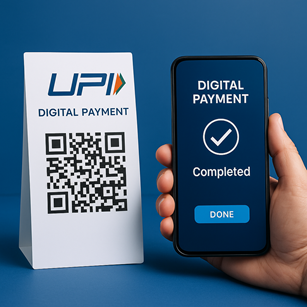(UPI is revolutionizing the Indian economy with fast, secure, and cashless transactions. Discover how UPI is shaping digital payments in 2025.)

UPI’s Economic Revolution in India: A 2025 Insight 🇮🇳💸
In recent years, India has witnessed a dramatic shift in how people transact daily, thanks to the Unified Payments Interface (UPI). Launched by the National Payments Corporation of India (NPCI), Unified Payments Interface. has become a cornerstone of India’s digital economy, processing over 12 billion transactions monthly as of March 2025. But how exactly is UPI impacting the Indian economy? Let’s explore the data, the trends, and the future.
📈 UPI Adoption Trends in 2025: What’s New?
India is now the global leader in real-time payments, with Unified Payments Interface at the center of this transformation. In 2025, Unified Payments Interface. continues to evolve with new features like UPI Lite, Credit Line on UPI, and International UPI payments.
Key 2025 Developments:
- UPI Lite: Allows small transactions without internet connectivity.
- UPI for NRIs: Enabled in countries like UAE, Singapore, and the US.
- Credit Line on UPI: Seamlessly offers instant credit at checkout.
- Voice-based UPI: AI-powered voice payments for feature phone users.
This evolution makes Unified Payments Interface accessible across all income and age groups, including those in rural India. The result? A more inclusive digital economy.
💼 How Unified Payments Interface Is Changing Businesses in India
Unified Payments Interface. has revolutionized both small and large businesses across India. Even local street vendors now accept digital payments via QR codes, reducing cash dependency and increasing transaction transparency.
Benefits for Businesses:
- Lower Transaction Costs: No MDR for most Unified Payments Interface transactions.
- Instant Settlements: Improved liquidity for small sellers.
- Digital Footprint: Helps build creditworthiness for MSMEs.
- Increased Sales: Convenience boosts customer confidence and conversion.
According to RBI data, Unified Payments Interface accounted for over ₹18 lakh crore in transaction value in March 2025 alone, marking a YoY growth of 50%.
👨💼 Empowering the Unbanked & Underbanked
Unified Payments Interface is more than just a payment tool—it’s a vehicle for financial inclusion.
- Bank Account Access: Linked accounts through Aadhaar and mobile.
- Jan Dhan Integration: Seamless payments for subsidy schemes and pensions.
- Digital Literacy: Government initiatives spreading awareness in Tier II & III cities.
With over 350 million Unified Payments Interface users as of April 2025, digital access is no longer limited to the urban elite.
🌐 UPI on the Global Stage: Going International
India is now exporting its Unified Payments Interface model globally. Countries like France, UAE, Bhutan, and Singapore have already signed MoUs for integrating Unified Payments Interface with their domestic payment systems.
This not only helps NRIs and travelers but also boosts India’s image as a fintech leader on the global map.
According to NPCI International, Unified Payments Interface-based cross-border payments are projected to grow by 120% YoY in 2025.
📊 Unified Payments Interface vs Other Payment Methods
| Payment Method | Processing Time | Cost | Popularity |
|---|---|---|---|
| UPI | Instant | Zero (mostly) | Very High |
| Credit Card | 1-3 Days | High | Medium |
| NEFT/RTGS | Hours | Low | Low |
| Wallets | Instant | Varies | Medium |
Unified Payments Interface offers the fastest, most cost-effective solution, especially for P2P and small business transactions.
http://upi-faces-technical-issues-users-report
🌟 Expert Opinions on UPI’s Economic Impact
Raghuram Rajan, former RBI Governor:
“Unified Payments Interface has given India an edge in the global fintech landscape. Its impact on small-scale commerce and financial inclusion is unparalleled.”
Nandan Nilekani, Aadhaar architect:
“Unified Payments Interface completes India’s digital stack. We’ve laid the foundation for the next-gen economy.”
🙋♀️ FAQs About Unified Payments Interface and Indian Economy
1. What is Unified Payments Interface and who developed it?
UPI, or Unified Payments Interface, is a real-time payment system developed by NPCI under the guidance of RBI and the Indian Banks’ Association.
2. How many transactions does Unified Payments Interface process per month in 2025?
As of March 2025, Unified Payments Interface processes over 12 billion transactions monthly.
3. Is Unified Payments Interface available for international users?
Yes, Unified Payments Interface is now live in several countries for NRIs, including UAE, Singapore, and France.
4. How is Unified Payments Interface helping rural India?
Unified Payments Interface enables cashless transactions even in remote areas via Unified Payments Interface Lite and voice-based services, promoting financial inclusion.
5. What are the benefits of Unified Payments Interface for small businesses?
It enables instant payments, zero MDR charges, better liquidity, and helps build a digital credit history for loans.
📣 Final Thoughts: UPI’s Role in India’s Digital Future
Unified Payments Interface is no longer just a payment tool—it’s a catalyst for economic transformation. From empowering vendors in small towns to enabling billion-dollar cross-border transactions, Unified Payments Interface is helping India transition into a digitally empowered, financially inclusive, and globally recognized economy.
With continuous innovation and government support, UPI is set to play an even more vital role in India’s $5 trillion economic vision.
🔔 Call to Action
Do you use UPI for daily payments? What changes have you noticed in the way India transacts? 💬 Share your views in the comments below. Don’t forget to share this article and follow QuickNews Press for more insightful updates on India’s digital economy.




